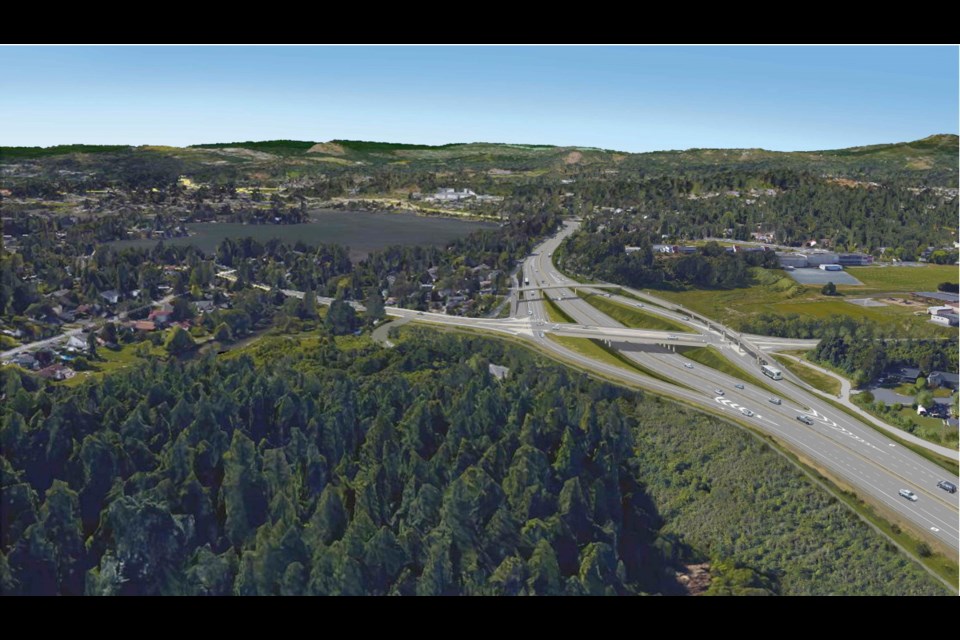There was an audacious government promise on Monday about eliminating a Greater Victoria traffic headache that has throbbed continually for a generation.
It involves the McKenzie interchange and the extension of the Westshore Parkway from the Trans-Canada Highway to Sooke Road.
Taking the wraps off three possible interchange designs, Transportation Minister Todd Stone said: “We’re very, very confident that this project, in conjunction with the Westshore Parkway, will go a long way toward eliminating what’s known as the Colwood Crawl.”
That bumper-to-bumper gridlock develops every rush hour on the highway and extends up McKenzie Avenue in the afternoons. It’s considered the worst traffic chokepoint in B.C. outside the Lower Mainland.
Public input will play a big part in selection of the three concepts presented Monday for an interchange over — or under — the highway.
Four months after announcing the $85-million project, Stone displayed three variations of what it could look like. Work is expected to begin in late 2016 and take two years to complete. But first a final design has to be chosen and the views of neighbours and people who use the intersection will be important, Stone said.
“We invite those who live in the area and rely on this corridor to have your say. It’s a critical part of getting the design right.”
Consultations start this afternoon, with an open house at St. Joseph the Worker Parish Hall, 753 Burnside Rd. West, 3 p.m. to 7 p.m.
All three concepts are considered feasible and within the budget and would achieve the goals of improving traffic flow.
Each one eliminates stoplights for through-traffic on the highway, each has longer merge lanes and each eliminates level crossings for the Galloping Goose trail. The conceptual drawings show the trail elevated on a bridge, but it could also go under motor traffic, Stone said.
The differences involve whether the highway goes over or under Admirals Road-McKenzie Avenue. Either way, left turns would involve stoplights at intersections adjacent to the interchange. A third option features a partial cloverleaf that would allow inbound traffic continual access to McKenzie Avenue without a stoplight, at the cost of encroaching on Cuthbert Holmes Park.
The project is jointly funded by the federal ($32.6 million) and provincial ($52.4 million) governments and was announced in July, 10 days before the federal election campaign started. Also announced that day was the $22.6-million extension of the Westshore Parkway, from the Trans-Canada to Highway 14 (Sooke Road), to which Langford is also contributing.
When former premier Mike Harcourt announced the start of the Inland Island Highway project in October 1993, the overall project included an interchange at McKenzie. But that component was later eliminated to save money. Traffic has been backing up ever since.
Stone said the designs all accommodate transit, pedestrians and cyclists, but high-occupancy vehicle lanes are not in the current designs.
Saanich Mayor Richard Atwell said he’s happy more than one option was presented, but he wants to learn more about any plans for the nearby McKenzie-Burnside intersection, which are still a mystery to the municipality.
Victoria-Swan Lake NDP MLA Rob Fleming said it’s a challenging project hemmed in by a park. The job might not be comprehensive enough to get the highway working properly, he said, and long-term transit needs and plans need to be addressed.
Gorge Tillicum Community Association president Rob Wickson said the project is strictly focused on cars, with no options for light rapid transit. “The cloverleaf [option] is horrible. It goes way too far into the park.” All three of the designs are awful and show no creativity, he said.
Some members of his group sketched their own design, which involves an underpass for outbound traffic, but retains the stoplight and left-turn lanes for inbound vehicles.



